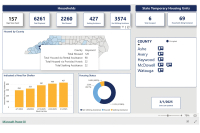Changing recreational habits challenge forest service
 The painstaking process of outlining a clear mission for the U.S. Forest Service and how it will manage its expansive public lands in Western North Carolina and the varied — and sometimes competing — interests of the people that use them has begun. Once completed, the new plan will serve as a reference for the coming 15 years on any major decision made about the Pisgah and Nantahala forests in regards to protected wilderness areas, logging, mountain biking, fires, hiking, hunting and more.
The painstaking process of outlining a clear mission for the U.S. Forest Service and how it will manage its expansive public lands in Western North Carolina and the varied — and sometimes competing — interests of the people that use them has begun. Once completed, the new plan will serve as a reference for the coming 15 years on any major decision made about the Pisgah and Nantahala forests in regards to protected wilderness areas, logging, mountain biking, fires, hiking, hunting and more.
To kickoff the multi-year planning process, the forest service is hosting a series of six public meetings in communities surrounding the Pisgah and Nantahala, collecting opinions from everyone from Boy Scouts and environmentalists to loggers and birdwatchers.
The public input collected, along with the forest service’s own analysis, will help guide the direction the plan takes. But if the crowd of folks attending the last of those meetings in Franklin last week was any indication as to what lies ahead, forest service staff will likely have its hands full trying to make everyone happy.
Macon County resident Bob Henry, who attended last week’s Franklin meeting, summed up nicely the task ahead for the forest service.
“Hunting does for me what bicycling and hiking does for you,” Henry said. “With the recreation aspect, a whole bunch of stuff gets involved. You’ve got to try to come up with a program that’s going to please everybody.”
Related Items
A hiker or mountain biker doesn’t necessarily want to cross a firing range on an afternoon pedal or stroll, and a hunter doesn’t necessarily want them disturbing their quiet hunt. Therein lies the challenge.
The 1.1 million acres of national forest land in WNC — split about evenly between the Nantahala and the Pisgah forests — has stayed relatively constant since the last long-range plan was written in 1987 and later revised in the mid 1990s. However, the number of forest users has skyrocketed. Last year, an estimated six to seven million people visited the Pisgah and Nantahala forests — two of the most visited forests in the United States.
The recreational habits of that increasing number of users changes with time, which may spell fun for outdoor enthusiasts but create new types of management challenges for the overseers. Case in point, said Forest Planner Ruth Berner, is mountain biking.
The non-motorized vehicle was hardly even on the radar when the last forest service plan was written, and still not registering when the revision was made. However, whichever way you look at it now, the mountain bike is here to stay.
“Before, mountain bikes were not around,” Berner said. “Now, they’re a huge issue on some of districts.”
But it’s not just changes in recreation demands and outdoor sporting preferences that are posing new challenges for the forest service. Private land around the national forests has been gobbled up by development, increasing the demand for outdoor recreation on public lands.
Raymond Bunn, a gunsmith from Jackson County, recounted how different hunting is today after decades of construction, new vacation homes and an upward trend in population.
“We’ve lost so much access on private lands that we used be able to hunt on,” Bunn said. “That’s why it’s important for the forest service to re-look at its plans. They have to help the wildlife.”
Helping wildlife from a hunter’s point of view, though, can be far different than helping the wildlife from a biologist’s perspective.
Many game species like deer, grouse and turkey thrive in sections of the forest disturbed by logging or other activities. Yet the populations of other, more sensitive forest species suffer greatly under the same conditions.
Josh Kelly, a public lands biologist with the Western North Carolina Alliance — an environmental group based Asheville — said this simple conundrum can make even a statement like “protect wildlife” seem like a unifying cry on the surface. But really it means very different things depending on who’s saying it.
“There’s a lot of public demand for increasing populations of deer and grouse, and they benefit from disturbance such as logging,” Kelly said.
The crux is that there are a lot of other species that have ranges restricted to the Blue Ridge Mountains, Kelly said, and can’t pick up and move to the Piedmont if their old growth tree forest gets cut.
Therefore, Kelly said his organization is pushing the forest service to expand protections against logging, mining and road construction to new areas of the forest that are biologically unique but vulnerable under the current plan.
Currently, he said about 60 percent of the forest is restricted from resource extraction such as mining and logging. But special areas like Corbin Knob in Jackson County and Cliff Ridge in Macon County are not.
“Logging, mining, also road building, threaten these areas,” Kelly said. “If they’re done in the wrong places, they can do a lot of damage.”
Brent Martin, southern Appalachian director for The Wilderness Society, said his organization is looking to increase the acreage of protected land in the forest, and, if possible, the amount designated as wilderness. Martin said wilderness land — 66,000 acres divided among five areas in the Nantahala and Pisgah forests — is currently underrepresented among the 1.1 million forest acres in WNC.
“We won’t be focusing solely on wilderness,” Martin said. “But we’d like to see more wilderness out of the plan.”
Logging and other resource extraction is not allowed in national forest wilderness areas, which also don’t allow road building.
Although the back and forth between environmentalists and loggers is an old turf battle, a new menace to conservation has come on the scene since the 1980s and 1990s: global climate change. And along with it, the proliferation of invaders like the emerald ash borer and the woolly adelgid.
Some of the forest areas where Kelly is lobbying for increased protections are high-altitude, cool ridgetops he hopes will serve as refuges for species moving up the mountain looking to escape the warming temperatures below. Also, with a prognosis of floods and droughts, protecting forested watersheds is a top priority.
“We want them to consider how important the Nantahala and Pisgah are in terms of climate adaptation,” Kelly said.
In the forest service’s other ear are the loggers trying to persuade the planning staff not to forget the local economy and the original intent of the nation’s federal forests. Created more than a century ago, America’s public lands were originally called forest reserves and were intended to set aside sustainable plots of trees for routine timber harvest.
“In 1891, that’s what it was set up for,” said David Jones of Cook Brothers Lumber in Macon County.
Jones said Cook Brothers employs 17 people at its local sawmill, spends millions of dollars locally buying supplies for its operations, and contributes money toward local government and schools through the timber it cuts on the Nantahala and Pisgah forests.
However, Jones contends that the amount of land logging operations have access too is ever shrinking. Plus, behind-the-scenes restrictions, like protecting the viewshed from the Appalachian Trail, further chip away at the industry’s stockpile of trees.
Jones would like to see more areas made available for logging as part of the new plan. The local economy depends on it, he said.
“How much revenue does anything else bring in other than timber — it doesn’t pay its way, it’s zero,” Jones said. “I enjoy getting out hiking and walking and fishing, but people aren’t looking at the big picture.”
After holding its six meetings near each of the local ranger districts, Berner said it was too soon to say what direction the new plan would take during the course of the next three to four years. However, she did acknowledge that the world around the Nantahala and Pisgah forests had changed, and that will most likely affect the final product and new direction of the forest service in WNC.
“Conditions have changed out here,” Berner said. “We’ll start with the plan that we have and see where we need to make adjustments.”
Sound-off
“One of the big changes we’d like to see is a more comprehensive look at unique biological places in the forest that currently receive no recognition from the Forest Service. We’d like to see the Forest Service recognize them and add some sort of management that protects them.”
— Josh Kelly, public lands biologist with Western North Carolina Alliance
“All the wildlife isn’t in the forest anymore, it’s down and around the houses. That’s one of my main goals — to see that changed and see some more habitat restoration for wildlife. And it benefits everybody. We all like to see wildlife as much as to hunt them.”
— Chris Hedden, president of the Nantahala Chapter of the National Wild Turkey Federation, Macon County
“I’ve lived here all my life, logged most of it, and I’ve noticed that timber cutting has decreased over the years. And I don’t know why. There’s plenty of recreation out there, trails and everything else; I think we need to focus more on economics than anything.”
— Marvin Cunningham, logger, Macon County
“I don’t think there should be any public lands people can’t get to. In other words, when you have wilderness areas without roads, they’re not accessible to people who need access. Plus, because these lands are ours they should not be excluded from us. I mean, what are they saving it for?”
— Dan Eichenbaum, ophthalmologist, Cherokee County
“I think the forest helps control growth and population density — which is what I moved away from — environmental impacts, water quality and air quality. I think it makes Western North Carolina a very enjoyable place to live because of the economic benefits and recreation opportunities that are available.”
— John Brill, retiree, Macon County
“The Nantahala National Forest has 15,000 acres with no management. Can you believe that, no management on 15,000 acres? It’s on in-holdings. An in-holding is a forest service tract surrounded by private land. You can’t get to it. They’ve never addressed this and the Forest Service needs to address this.”
— Tom Thrash, Former U.S. forest service employee









